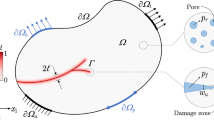The paper is concerned with the fracture process zone at the tip of a crack at the nonsmooth interface between isotropic elastic media. A plane symmetric problem is formulated. The zone is modeled by lines of discontinuity of the normal displacement at the interface. The exact solution of the elastic problem is found by the Wiener-Hopf method
Similar content being viewed by others
References
V. F. Bakirov and R. V. Gol'dshtein, “Leonov-Panasyuk-Dugdale model for an interface crack,” Prikl. Mat. Mekh., 68, No. 1, 170–179 (2004).
A. N. Guz, “Critical phenomena in cracking of the interface between two prestressed materials. 1. Problem formulation and basic relations,” Int. Appl. Mech., 38, No. 4, 423–431 (2002).
M. V. Dudik, L. A. Kipnis, and A. V. Pavlenko, “Analysis of plastic slip lines at the tip of a crack terminating at the interface of different media,” Int. Appl. Mech., 38, No. 2, 197–202 (2002).
J. Dundurs and M. Komninou, “Review of and prospect for interphase crack research,” Mekh. Komp. Mater., No. 3, 387–396 (1979).
A. A. Kaminsky, L. A. Kipnis, and V. A. Kolmakova, “On the Dugdaill model for a crack at the interface of different media,” Int. Appl. Mech., 35, No. 1, 58–63 (1999).
A. A. Kaminsky and S. B. Nizhnik, “Study of the laws governing the change in the plastic zone at the crack tip and characteristics of the fracture toughness of metallic materials in relation to their structure (survey),” Int. Appl. Mech., 31, No. 10, 777–798 (1995).
A. A. Kaminsky, G. I. Usikova, and E. A. Dmitrieva, “Experimental study of the distribution of plastic strains near a crack tip during static loading,” Int. Appl. Mech., 30, No. 11, 892–897 (1994).
V. V. Loboda and A. E. Sheveleva, “Determining prefracture zones at a crack tip between two elastic orthotropic bodies,” Int. Appl. Mech., 39, No. 5, 566–572 (2003).
B. Noble, Methods Based on the Wiener-Hopf Technique for the Solution of Partial Differential Equations, Pergamon Press, London (1958).
A. A. Kaminsky, M. V. Dudik, V. N. Dyakon, and N. I. Zatula, “Behavior of stresses near the tip of a crack reaching the interface between dissimilar media,” in: Theoretical and Applied Mechanic, Issue 32, Osnova, Kharkov (2001), pp. 103–108.
V. V. Panasyuk, Limit Equilibrium of Brittle Bodies with Cracks [in Russian], Naukova Dumka, Kyiv (1968).
V. Z. Parton and P. I. Perlin, Methods of the Mathematical Theory of Elasticity [in Russian], Nauka, Moscow (1981).
I. V. Simonov, “Crack at an interface in a uniform stress field,” Mech. Comp. Mater., 21, No. 6, 650–657 (1986).
Ya. S. Uflyand, Integral Transforms in Problems of Elasticity [in Russian], Nauka, Leningrad (1967).
G. P. Cherepanov, Brittle Fracture Mechanics [in Russian], Nauka, Moscow (1974).
A. N. Guz and I. A. Guz, “On models in the theory of stability of multiwalled carbon nanotubes in matrix,” Int. Appl. Mech., 42, No. 6, 617–628 (2006).
A. A. Kaminsky, M. V. Dudik, and L. A. Kipnis, “On the direction of development of a thin fracture process zone at the tip of an interfacial crack between dissimilar media,” Int. Appl. Mech., 42, No. 2, 136–144 (2006).
A. A. Kaminsky, L. A. Kipnis, and M. V. Dudik, “Initial development of the prefracture zone near the tip of a crack reaching the interface between dissimilar media,” Int. Appl. Mech., 40, No. 2, 176–182 (2004).
A. A. Kaminsky, L. A. Kipnis, and G. A. Khazin, “A criterion for the onset of growth of two shear cracks in an elastic body under plane-strain conditions,” Int. Appl. Mech., 42, No. 4, 439–446 (2006).
A. A. Kaminsky, M. V. Dudik, and L. A. Kipnis, “Initial kinking of an interface crack between two elastic media,” Int. Appl. Mech., 43, No. 10, 1090–1099 (2007).
J. B. Leblond and J. Frelat, “Crack kinking from an interface crack with initial contact between the crack lips,” Eur. J. Mech. A/Solids, 20, 937–951 (2001).
Author information
Authors and Affiliations
Corresponding author
Additional information
Translated from Prikladnaya Mekhanika, Vol. 44, No. 10, pp. 13–22, October 2008.
Rights and permissions
About this article
Cite this article
Kaminsky, A.A., Kipnis, L.A. & Kolmakova, V.A. Model of the fracture process zone at the tip of a crack reaching the nonsmooth interface between elastic media. Int Appl Mech 44, 1084–1092 (2008). https://doi.org/10.1007/s10778-009-0131-9
Received:
Published:
Issue Date:
DOI: https://doi.org/10.1007/s10778-009-0131-9




